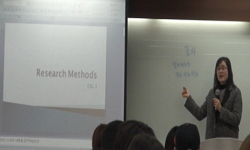There has been a growing amount of necessity for self-learning due to the increasing number of the learners of Japanese as well as various types of learners, against the situation where IT-technologies have been developed and the paradigm of Japanese ...
http://chineseinput.net/에서 pinyin(병음)방식으로 중국어를 변환할 수 있습니다.
변환된 중국어를 복사하여 사용하시면 됩니다.
- 中文 을 입력하시려면 zhongwen을 입력하시고 space를누르시면됩니다.
- 北京 을 입력하시려면 beijing을 입력하시고 space를 누르시면 됩니다.

e-learning을 통한 자율학습의 기초적 연구 및 실천 사례 : 조사의 오용례를 중심으로 = A Preliminary Survey of Self-Learning based on E-Learning - A Case Study of the Misuses of Postpositional Particles
한글로보기https://www.riss.kr/link?id=A101780817
- 저자
- 발행기관
- 학술지명
- 권호사항
-
발행연도
2016
-
작성언어
-
-
주제어
자율학습 ; 자기정정 ; 피드백 ; 조사 ; self-learning ; e-learning ; self-correction ; feedback ; particle
-
KDC
830
-
등재정보
KCI등재
-
자료형태
학술저널
- 발행기관 URL
-
수록면
163-186(24쪽)
- DOI식별코드
- 제공처
- 소장기관
-
0
상세조회 -
0
다운로드
부가정보
다국어 초록 (Multilingual Abstract)
There has been a growing amount of necessity for self-learning due to the increasing number of the learners of Japanese as well as various types of learners, against the situation where IT-technologies have been developed and the paradigm of Japanese teaching has been shifted. In this article, we shall attempt to point out the effectiveness of selflearning by presenting a case study of the “e-learning” method. We applied the method to the learning of particles in composition class since the wrong use of grammar/vocabulary is observed frequently particularly in the case of particles. Our analysis based on the self-correction feedback reveals that the method is quite effective. Nevertheless, though it is relatively easy for the learners to self-correct the misuses of particles, a large amount of time may be required due to the high frequency of misused particles. Thus, multiple feedbacks are effective, as demonstrated in our survey with regard to three self-correction feedbacks. This result is also supported by a questionnaire test, where the leaners reported that they found it quite effective to selfcorrect their own mistakes.
목차 (Table of Contents)
- 요약
- 1. 들어가기
- 2. 선행연구
- 3. e-learning을 통한 자율학습
- 4. e-learning 자율학습 지원 플랫폼 서비스 및 운영 사례
- 요약
- 1. 들어가기
- 2. 선행연구
- 3. e-learning을 통한 자율학습
- 4. e-learning 자율학습 지원 플랫폼 서비스 및 운영 사례
- 5. e-learning 일본어 자율학습 수업 실천
- 6. 고찰
- 7. 결론
- 참고문헌
- <Abstract>
동일학술지(권/호) 다른 논문
-
플립러닝(Flipped Learnig)을 활용한 일본어교육 사례 연구
- 일본어문학회
- 趙大夏(Cho Dai Ha)
- 2016
- KCI등재
-
- 일본어문학회
- 元智恩(Won Ji Eun)
- 2016
- KCI등재
-
表現意圖를 나타내는 韓國人日本語 學習者의 終助詞 ‘ね’에 관한 音響音聲學的인 特徵
- 일본어문학회
- 金妵
- 2016
- KCI등재
-
- 일본어문학회
- 金秀珍(Kim Soo Jin)
- 2016
- KCI등재




 KCI
KCI 스콜라
스콜라







